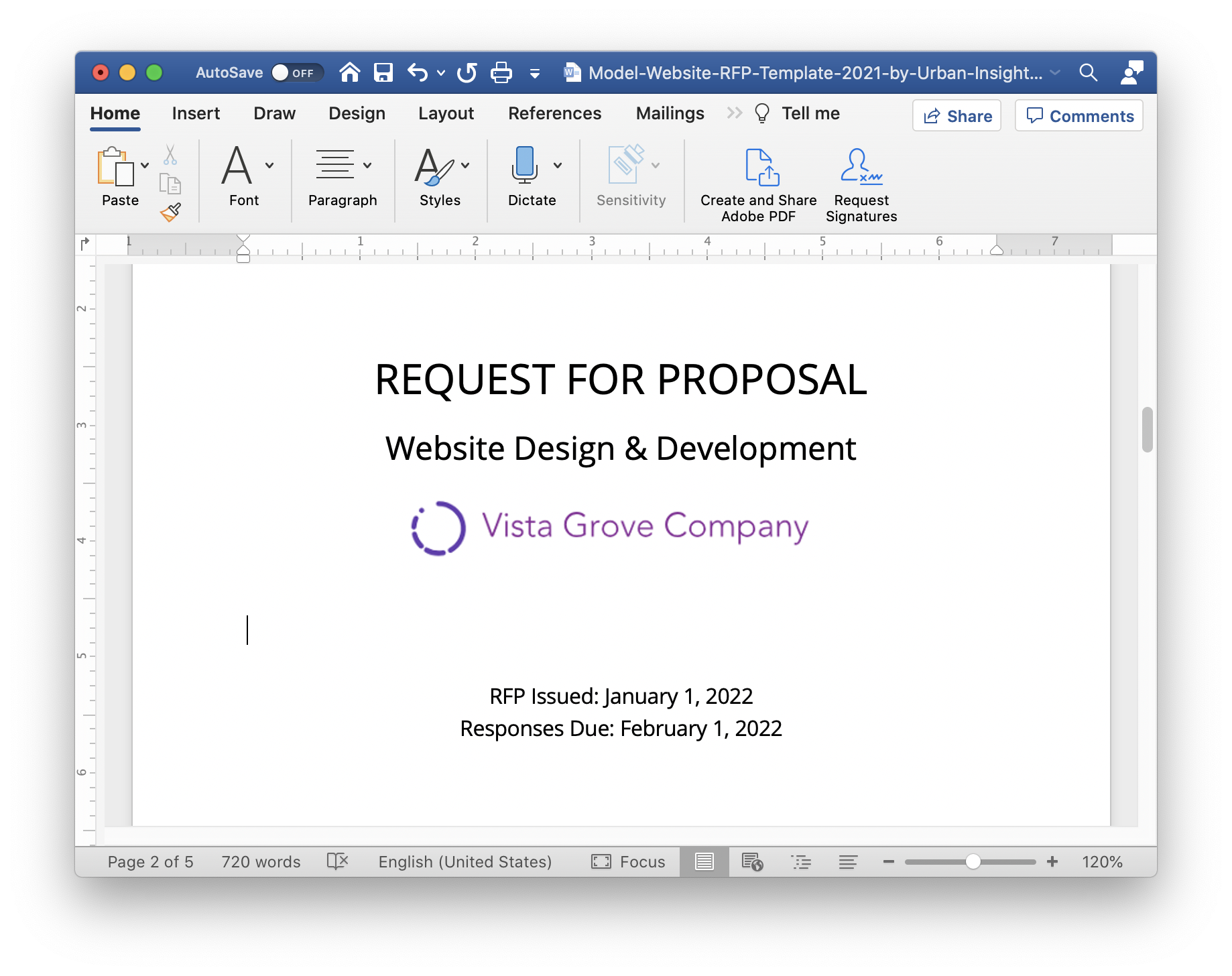Many organizations will create a request for proposal (RFP) to invite agencies to bid on their website redesign and development project. Unfortunately, many RFPs drive away exactly the kind of agency that the organization wants. We've seen thousands (really, thousands) of RFPs over the years. Some are really great. Many are not.
So we created the RFP that we'd want to receive. This is a user-friendly website RFP example that provides the critical details required for us to
- understand the scope of the project, website, and/or web application, and your organization's target audience
- evaluate if we're the right fit for your specific project
- and prepare a proposal and an accurate estimate of costs.
What Is a Request for Proposal?
An organization may issue a detailed document known as a Request for Proposal (RFP) to invite proposals from prospective vendors for a project or service. This RFP outlines project requirements, criteria for vendor selection, and deadlines. By outlining these elements, an RFP enables organizations to systematically compare different proposals. This ensures the organization can assess the capabilities of various vendors against their needs and choose the vendor most suitable for successful project execution. It is an essential tool for transparent procurement and strategic vendor engagement.
When is the right time to prepare an RFP?
The right time to prepare an RFP is when you recognize the need for a new or redesigned website or web application. This process helps in exploring vendor options and understanding market costs.
In some cases, bypassing the RFP process may be appropriate if you have a preferred vendor or face constraints that limit competitive bidding, such as urgent timelines or highly specialized project requirements where pre-selected expertise is crucial.
What makes an RFP strong?
A strong Request for Proposal (RFP) is characterized primarily by its clarity in outlining the project's scope and parameters. Clear descriptions ensure that all potential vendors understand the project's requirements, objectives, and limitations. This transparency helps in attracting well-matched proposals, reduces misunderstandings, and facilitates the comparison of bids. Additionally, a detailed RFP should include specific criteria for vendor selection and realistic timelines, enhancing the likelihood of a successful partnership and project outcome.
What sets Urban Insight's RFP Template apart?
The Model Website RFP Template we created will ensure that whichever agency you choose to work with can immediately commence project planning and hit the ground running.
This RFP template is intentionally short, at four pages, so that you can complete it in less than 1 hour, so you can get your project moving forward and find the right agency / potential vendor to work alongside you.

We created this Model Website RFP Template in collaboration with several leading digital agencies, based on observed user experience and frequently asked questions from many previous website RFP templates.
This RFP example provides you with a concise, easy-to-modify template that will help your organization think through the scope of work for your website project and present it in a way that will help you find the best agency partner. The template includes reusable sample content for a fictional organization called the "Vista Grove Company," so you can review an example of what is expected in the RFP.
Our goal with the Model Website RFP Template is to help make requests for proposals (RFPs) a little bit better by helping organizations think through the questions an agency will likely have.
Formatting your RFP
Ideally, you should structure your RFP in a clear and organized manner including helpful information for vendors. Below is a general overview of the 9 sections of the downloadable template to support your RFP process along with sample content:
- Cover Page
- Contact Information
- Organization Background
- Project Overview
- Project Goals
- Other Requirements (with some examples)
- Schedule / Project Timeline
- Budget Constraints
- Evaluation Metrics (e.g., time frame, project management, team member resumes)
- Submission Requirements
Keep reading the following step-by-step overview that will guide you through writing a comprehensive RFP that effectively communicates your needs to potential vendors. By following these steps, you will help ensure you receive well-matched proposals for your website design or redesign project. After you review the below how-to, download the Model Website RFP Template to customize your own RFP.
Steps to write the perfect RFP
Creating a Request for Proposal (RFP) is crucial for web development projects as it clearly communicates your project needs to potential vendors and invites vendors to engage deeply with your project, ultimately laying the foundation for a successful partnership and superior final product.
This structured approach to writing your RFP will help ensure that you attract qualified vendors capable of delivering a website that meets your strategic goals.
Here is a step-by-step guide to crafting an effective website RFP based on our downloadable Model Website RFP Template.
Step 1: Understand the Purpose of Your RFP
Begin by recognizing that the RFP serves to formalize your needs and expectations, making it essential for aligning potential vendors with your project objectives. A well-drafted RFP should act as a comprehensive guide that informs vendors about the specifics of the project and the criteria for selection.
Remember the purpose of creating your RFP includes:
- Understanding vendor compatibility and capabilities
- Clarifying project goals, functionalities, and constraints
- Facilitating accurate quotes from vendors.
Step 2: Tailor the Template to Your Needs
Use the provided "Model Website RFP Template" as a starting point. Adjust the sections to reflect the specifics of your project and organization. Remember, while the template provides a structured format, customization is key to reflect your unique requirements.
Step 3: Draft the Introduction
Begin by clearly stating the purpose of the RFP, emphasizing its role in selecting the right vendor for your project. Provide a concise overview of your organization, such as the example of Vista Grove Company. Detail the nature of your services and the sectors you serve, including key demographics of your target audience. This introduction sets the context for vendors, enabling them to understand the scope and relevance of the project, ensuring their proposals are accurately tailored to meet your specific needs and objectives.
Step 4: Provide Detailed Project Information
- Project Overview: Clearly describe what you aim to achieve with the website design or redesign project. For example, highlight the importance of enhancing brand visibility, improving user experience, or increasing lead generation. Providing a detailed narrative of your company’s journey and its future direction can give vendors a clearer picture of your aspirations, enhancing their ability to propose a tailored solution.
- Goals: Enumerate specific objectives like modernizing design, increasing traffic, and integrating marketing automation tools like HubSpot. Delineating the technical specifications and performance metrics that the new website should meet can help prevent scope creep and ensure that you receive proposals that precisely meet your needs.
Step 5: List Other Requirements
Detail any additional functionalities or features needed, including but not limited to
- Accessibility compliance
- Marketing automation
- Video training.
This section helps vendors understand the scope and technical demands of the project.
Step 6: Define the Schedule and Budget
- Schedule: Offer two options — either invite vendors to propose a timeline based on their understanding of the project scope or specify a deadline tied to an organizational milestone or event.
- Budget Constraints: Be transparent about your budget range to ensure alignment and avoid miscommunication.
Discussing your flexibility with the project timeline and budget can open the door to more creative and effective proposals. Vendors appreciate knowing whether there is room for innovative solutions that might require a slightly higher investment or extended timeline.
Step 7: Set Evaluation Metrics
Clearly outline the criteria on which proposals will be evaluated. This could include design capabilities, previous experience, cost-effectiveness, and ability to provide ongoing support.
Encouraging a dialogue within the RFP process by asking vendors to suggest alternatives and improvements to your initial requirements can lead to better outcomes.
This approach not only fosters a collaborative atmosphere but also signals to vendors that you value their expertise and are open to their recommendations.
Step 8: Submission Requirements
Detail what needs to be included in the proposals:
- Examples of similar work.
- Summary of the vendor’s process and approach.
- Proposed timeline and detailed budget.
- Bios of key team members and information on any subcontractors.
- Options for ongoing support and hosting.
Step 9: Closing Statement
Thank your prospective vendors for their interest and encourage them to submit their proposals by the specified deadline.
Step 10: Review and Revise
Before sending out your RFP, review it thoroughly to ensure all information is clear and no critical details are missing. Consider having it reviewed by stakeholders in different departments to ensure all technical and business requirements are accurately represented.
Final Step: Distribute Your RFP
Send your RFP to a carefully selected list of potential vendors.
This structured approach to writing your RFP will help ensure that you attract qualified vendors capable of delivering a website that meets your strategic goals.
Download the FREE Model RFP Website Template Now
You can download the Model Website RFP Template in Word and PDF format for free. (Full disclosure, we do ask for your name and email address to follow-up with you once in a while.)
We hope this document helps you write a high-quality RFP that excites you and attracts prospective vendors who are a great fit for your website development or design project.
We look forward to hearing how you are using the Model Website Redesign RFP in your organization.
Need a Museum RFP Template for Web Development?
Looking for a model request for proposal template for a museum project? Look no further than our Museum RFP Template for Web Development.


